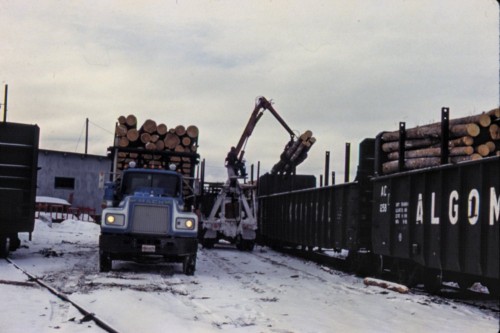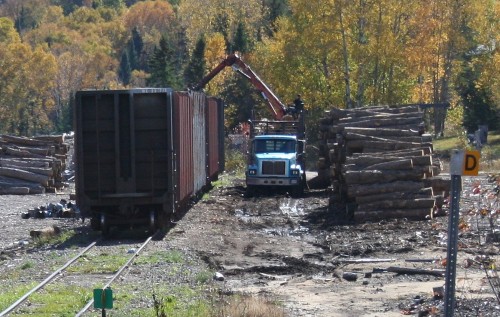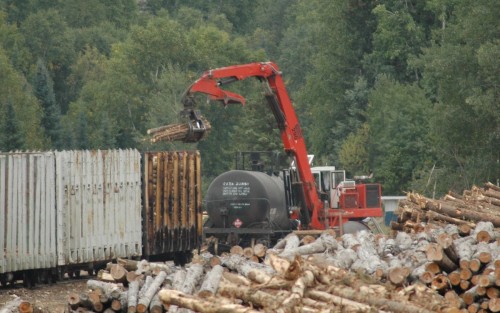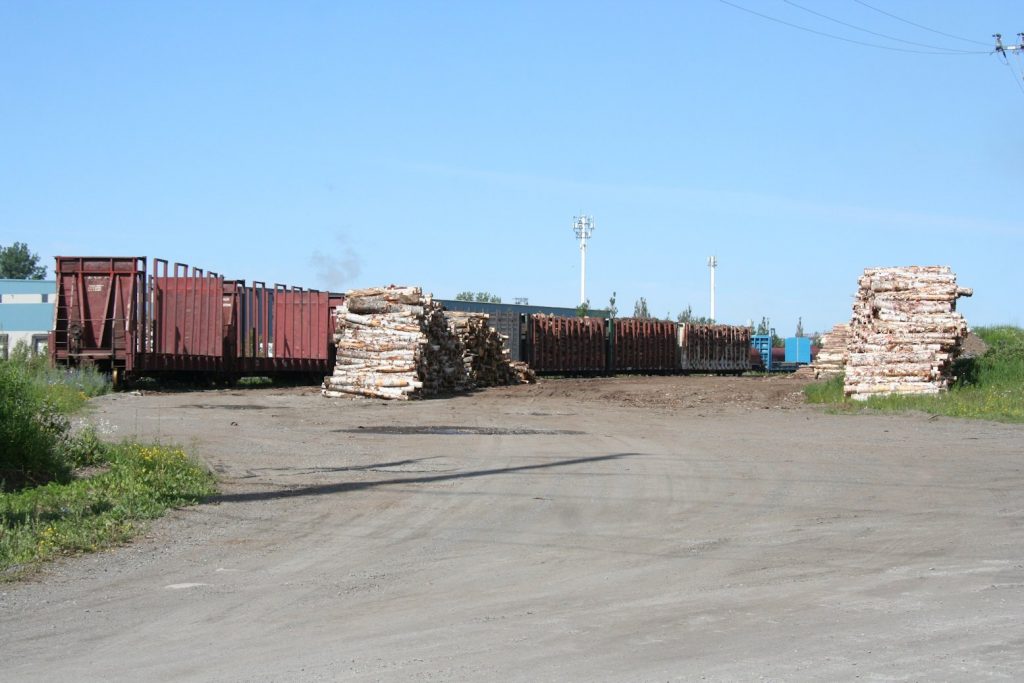
Tag Archives: Pulpwood
Freight Car Friday #76 – AC 238405
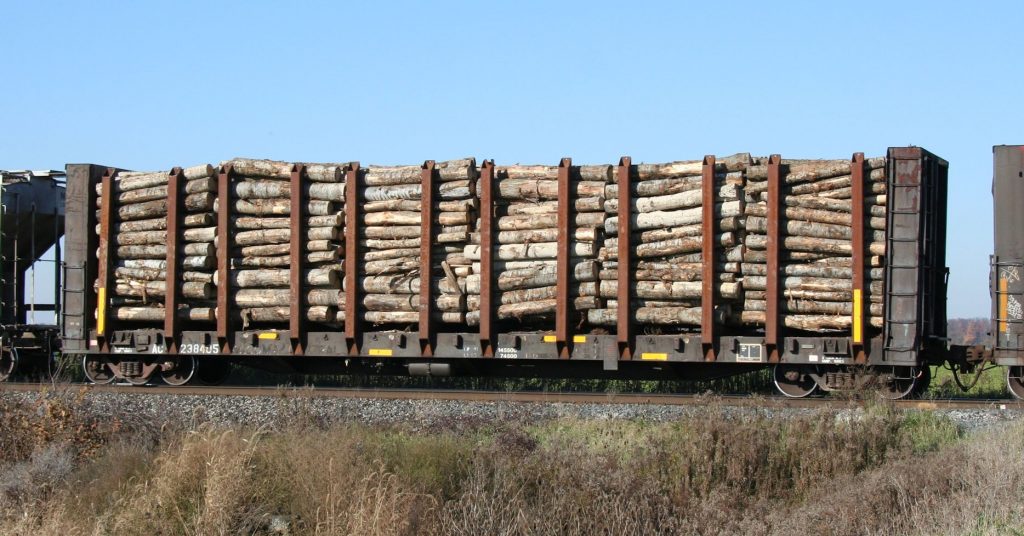
As mentioned in a previous post, blocks of loaded pulpwood flatcars have been common rolling though southern Ontario on CN M397 for the last year and a half since CN has put the south end of the former Algoma Central on mothballs. I believe that these are loaded on a busy log spur at Mead on the former ACR and routed around Lake Huron via Toronto and Chicago to get to mills in Wisconsin.
Most of these cars bear WC reporting marks, and are a wild variety of former CN-family cars from different groupings, including BC Rail, Duluth, Winnipeg & Pacific, CN, and even other Wisconsin Central and Algoma Central cars.
Most of the old Algoma Central-marked flatcars in the 2384xx and 2385xx series are also still in service, and also occasionally show up mixed in, although they are dominated in terms of sheer numbers by the hundreds of cars in the WC 237000-238xxx block.
Last Sunday’s 4-car pulpwood block on 397 contained this treat for an ACR fan. AC 238405, formerly of AC 2401-2425 series built new for the ACR in 1975 as standard 52’10” bulkhead flatcars and converted to a pulpwood car by Wisconsin Central in 1998. The original lettering is quite worn, but you can still see the original “ALGOMA CENTRAL” lettering to the right of the new car number.
Freight Car Friday #75 – WC 237703
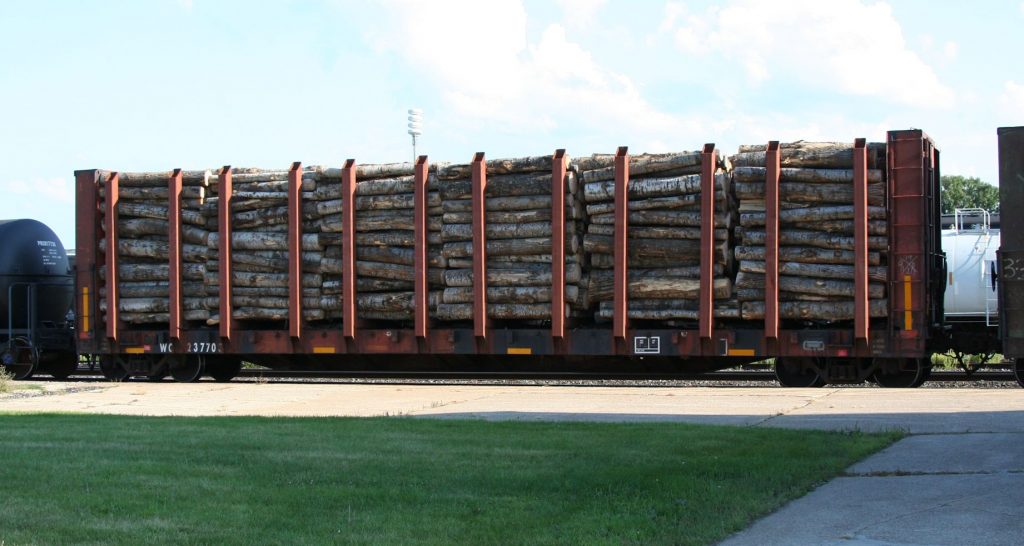
Since sprint of 2020, when CN mothballed the former Algoma Central line between Sault Ste. Marie and Hawk Junction (no freight has run south of Hawk since April 2020) loads of pulpwood in AC/WC flatcars have been a relatively common sight running through southern Ontario on Toronto to Chicago train M397. A log loading operation at Mead (former location of the old Newaygo sawmill that operated between 1974-85) is one of the only major customers on the former AC line, and with the line unused south of Hawk these loads take the long route to northern Michigan/Wisconsin via Toronto and Chicago.
It’s not uncommon to actually see AC-marked pulpwood cars mixed in with the WC ones – most of the AC 238100, 238400, and 238500 series cars are still active – but this WC car in particular happened to catch my eye out of a block of nine loaded WC cars on August 2nd’s CN M397 through my hometown of Sarnia.
The WC 237000-238000 series of converted pulpwood flatcars is a wild range of old flatcars from many previous CN-family (mostly DWC and BCOL, but also other former CN and WC cars) rebuilt and renumbered with very little organization to what prior groups the cars are pulled from, just renumbered into the series as they’re converted.
The orange colour of WC 237703, and some of the paint patchwork underneath the most recent patches for the new WC number and the log bunks suggested a North American Car Co. (NAFX) heritage – likely via AC 2476-2494 series. Some cooperation on facebook with a couple of guys with access to the UMLER (Universal Machine Language Equipment Register) – the common electronic equipment database used by North America’s railways – helped confirm that the previous identity of WC 237703 was in fact AC 2489, and its original number before being acquired by the Algoma Central (in 1994) was NAFX 53201 (from NAFX series 53200-53249).
Custom Finishing Log Truck Kit – Frame and Modifications
With pulpwood loading operations being a major feature of the Algoma Central Railway, I want to have some vehicles and loading equipment as well to feature at at least a few of the loading spots on the layout. To that end, some while back I picked up a couple of Custom Finishing pulpwood truck conversion kits. These kits are cast in white metal and contain all the parts including log bunks and parts for an integrated loading crane to kitbash from a semi truck model (you have to supply the base truck to combine with the kit.)
The Custom Finishing Kit has a cast metal frame piece and the instructions indicate that it is designed to fit the old Atlas Ford “LNT” truck. I didn’t have any Atlas trucks but I did have an old Athearn Kenworth truck kicking around from my old 4×8 layout in my parent’s basement 20 years ago. I didn’t have any other real use for this truck cab so I decided to convert this into the pulpwood truck.
I did my own frame modifications on this one, removing the fifth wheel and filling any remaining nubs and raised detail flat on the top surface of the rear frame and cutting the frame right in front of the axle springs. The frame was extended with pieces of HO 4×10 strip and capped with a piece cut from .040″ sheet. A few pieces of .010x.040″ strip along the bottom of the frame also helped reinforce and strengthen the joints.
The fuel tanks in the Athearn kit are designed to sort of clip on over the frame, which looks rather toy-like. I cut the mounting clips off of the tanks and glued them directly to the sides of the frame, which looks a little better.
The rest of the frame conversion consists of gluing the protective bars and log bunks to the frame with CA, as well as the assembled base for the integrated log handling crane. There’s also an end piece for the frame.
Log Loading Equipment and an Interesting Idea about Traffic
Other than iron ore from Wawa, and finished products from Algoma Steel created from said iron ore, one of the primary cargoes carried on the Algoma Central Railway was pulpwood.
Over the years a number of private spurs operated by different logging and forestry companies are listed in employee timetables, as well as other major operations loading from a clearing alongside the railway’s house track at various sidings.
So, with pulpwood loading being such a significant source of traffic on the ACR (or in several locations on pretty much all other Northern Ontario and Quebec lines) anyone modeling the ACR or really any model railways loosely based on Northern Ontario will want to include some pulpwood traffic at least, and probably actually at least one loading spur somewhere to represent this.
So I thought I’d share a series of my photos of different pulpwood loading locations and take a look what such an operation looks like. We find that the common word here is “simplicity”. Loading pulpwood does not require large overhead cranes or loading equipment (although at some larger saw mills like the Tembec mill at Hearst massive cranes make short work of moving tree-length logs between railcars or trucks and a large storage pile and the mill), enclosed loading bays, conveyors, dump pits, etc. All that is needed in most cases is simply a flat cleared area next to the tracks where trucks can drive up and unload their logs either directly into waiting railcars or into a storage pile. There are no fixed structures required to model, but the log trucks and other self-propelled equipment are of definite interest.
This first photo is from my slide collection (photographer’s name unknown) and is taken at the Hawk Junction in early 1981 showing a pair of trucks loading gondola cars with logs on the team track behind the old railway freight shed (the grey building at background left).
Note that the truck in the middle (and likely the one at left as well) has its own hydraulic loading crane permanently mounted directly to the rear of the truck itself. Not all trucks will have this, but the self loader is a fairly common feature that allows the truck itself to also include the required loading equipment.
Unfortunately I haven’t taken the chance to actually personally photograph any individual trucks directly, but a google image search for “pulpwood truck” will turn up some good results.
This photo is from the Huron Central ex-CP yard in Sault Ste. Marie. These two south tracks of the yard are always jammed with pulpwood flatcars which are loaded here for shipment to the paper mill at Espanola, ON on the Huron Central between Sault Ste. Marie and Sudbury. The facility is no more involved than a wide driveway along the track running the length of the yard. For the detail-oriented, I noted in most of my closer shots of individual railcars on these tracks quite a bit of bark and other debris alongside the rails where trucks load the cars.
This photo was taken at Eton from my trip on the Tour of the Line in fall 2013. Here again we see another log truck equipped with a self loader on the rear loading logs into flatcars on the spur track. While this photo really only shows about a quarter to a third of the operation here (there is a second spur to the left and this shows only a portion of the cleared area) the unseen parts are simply more of the same and this shot really shows all that is required for a log loading operation.
This last photo was again taken at Eton, this time in 2005, and was sent to me by Steve Watson to illustrate the loading equipment. The machine this time is a SERCO Model 290 log loader; a larger specialized stand alone piece of equipment.
This photo also shows something else that is interesting. Notice the tank car (with diesel fuel placards) spotted at the very end of the spur track. While some pulpwood is delivered via the main highway system and loaded at spur tracks in or near town, some of these logging spurs can be pretty isolated from any regular road system (I was able to actually trace a logging road from Eton through Frater on satellite imagery, but it’s a pretty long and circuitous route over what’s likely some pretty poor excuses for roads, and even then you’re still 100 miles north of Sault Ste. Marie on Highway 17 by the time you get to the main road), making bringing in a tanker truck to refuel your logging trucks and other equipment a difficult proposition.
So an interesting idea to add to your operation, if the logging camp is particularly remote, is to occasionally spot a tank car of diesel fuel at the very end of a spur to refuel all your trucks. This sounds like something I can do at my pulpwood camp at Mosher which was also pretty isolated. I’ve heard this location also had portable unloading ramp on the north spur where trucks and other equipment could be brought in to the camp and older equipment was just sometimes abandoned there since there was little to no access to the outside road system from the logging road network around Mosher at the time.



